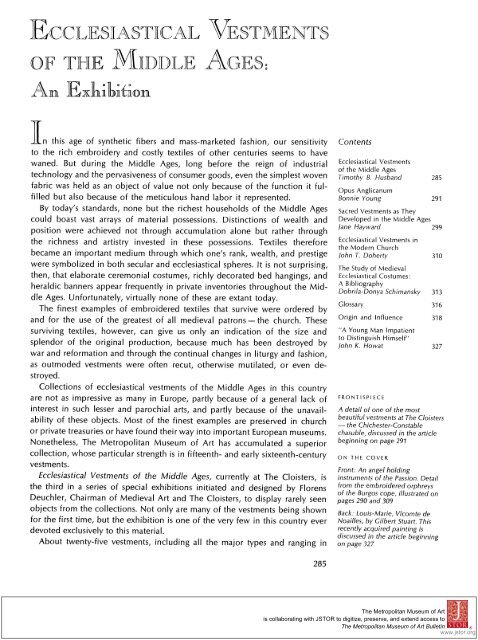The Metropolitan Museum of Art Bulletin, v. 29, no. 7 (March, 1971)
The Metropolitan Museum of Art Bulletin, v. 29, no. 7 (March, 1971)
The Metropolitan Museum of Art Bulletin, v. 29, no. 7 (March, 1971)
You also want an ePaper? Increase the reach of your titles
YUMPU automatically turns print PDFs into web optimized ePapers that Google loves.
ECCLES ASTCAL VE STMENTS<br />
OF THE MIDDLE AGESn<br />
An<br />
EJli;ioi<br />
I'n this age <strong>of</strong> synthetic fibers and mass-marketed fashion, our sensitivity<br />
to the rich embroidery and costly textiles <strong>of</strong> other centuries seems to have<br />
waned. But during the Middle Ages, long before the reign <strong>of</strong> industrial<br />
tech<strong>no</strong>logy and the pervasiveness <strong>of</strong> consumer goods, even the simplest woven<br />
fabric was held as an object <strong>of</strong> value <strong>no</strong>t only because <strong>of</strong> the function it fulfilled<br />
but also because <strong>of</strong> the meticulous hand labor it represented.<br />
By today's standards, <strong>no</strong>ne but the richest households <strong>of</strong> the Middle Ages<br />
could boast vast arrays <strong>of</strong> material possessions. Distinctions <strong>of</strong> wealth and<br />
position were achieved <strong>no</strong>t through accumulation alone but rather through<br />
the richness and artistry invested in these possessions. Textiles therefore<br />
became an important medium through which one's rank, wealth, and prestige<br />
were symbolized in both secular and ecclesiastical spheres. It is <strong>no</strong>t surprising,<br />
then, that elaborate ceremonial costumes, richly decorated bed hangings, and<br />
heraldic banners appear frequently in private inventories throughout the Middle<br />
Ages. Unfortunately, virtually <strong>no</strong>ne <strong>of</strong> these are extant today.<br />
<strong>The</strong> finest examples <strong>of</strong> embroidered textiles that survive were ordered by<br />
and for the use <strong>of</strong> the greatest <strong>of</strong> all medieval patrons-the church. <strong>The</strong>se<br />
surviving textiles, however, can give us only an indication <strong>of</strong> the size and<br />
splendor <strong>of</strong> the original production, because much has been destroyed by<br />
war and reformation and through the continual changes in liturgy and fashion,<br />
as outmoded vestments were <strong>of</strong>ten recut, otherwise mutilated, or even destroyed.<br />
Collections <strong>of</strong> ecclesiastical vestments <strong>of</strong> the Middle Ages in this country<br />
are <strong>no</strong>t as impressive as many in Europe, partly because <strong>of</strong> a general lack <strong>of</strong><br />
interest in such lesser and parochial arts, and partly because <strong>of</strong> the unavailability<br />
<strong>of</strong> these objects. Most <strong>of</strong> the finest examples are preserved in church<br />
or private treasuries or have found their way into important European museums.<br />
Nonetheless, <strong>The</strong> <strong>Metropolitan</strong> <strong>Museum</strong> <strong>of</strong> <strong>Art</strong> has accumulated a superior<br />
collection, whose particular strength is in fifteenth- and early sixteenth-century<br />
vestments.<br />
Ecclesiastical Vestments <strong>of</strong> the Middle Ages, currently at <strong>The</strong> Cloisters, is<br />
the third in a series <strong>of</strong> special exhibitions initiated and designed by Florens<br />
Deuchler, Chairman <strong>of</strong> Medieval <strong>Art</strong> and <strong>The</strong> Cloisters, to display rarely seen<br />
objects from the collections. Not only are many <strong>of</strong> the vestments being shown<br />
for the first time, but the exhibition is one <strong>of</strong> the very few in this country ever<br />
devoted exclusively to this material.<br />
About twenty-five vestments, including all the major types and ranging in<br />
285<br />
Contents<br />
Ecclesiastical Vestments<br />
<strong>of</strong> the Middle Ages<br />
Timothy B. Husband<br />
Opus Anglicanum<br />
Bonnie Young<br />
Sacred Vestments as <strong>The</strong>y<br />
Developed in the Middle Ages<br />
Jane Hayward <strong>29</strong>9<br />
Ecclesiastical Vestments in<br />
the Modern Church<br />
John T. Doherty 310<br />
<strong>The</strong> Study <strong>of</strong> Medieval<br />
Ecclesiastical Costumes:<br />
A Bibliography<br />
Dobrila-Donya Schimansky 313<br />
Glossary 316<br />
Origin and Influence 318<br />
"A Young Man Impatient<br />
to Distinguish Himself"<br />
John K. Howat 327<br />
FRONTISPIECE<br />
A detail <strong>of</strong> one <strong>of</strong> the most<br />
beautiful vestments at <strong>The</strong> Cloisters<br />
- the Chichester-Constable<br />
chasuble, discussed in the article<br />
beginning on page <strong>29</strong>1<br />
ON THE COVER<br />
285<br />
<strong>29</strong>1<br />
Front: An angel holding<br />
instruments <strong>of</strong> the Passion. Detail<br />
from the embroidered orphreys<br />
<strong>of</strong> the Burgos cope, illustrated on<br />
pages <strong>29</strong>0 and 309<br />
Back: Louis-Marie, Vicomte de<br />
Noailles, by Gilbert Stuart. This<br />
recently acquired painting is<br />
discussed in the article beginning<br />
on page 327<br />
<strong>The</strong> <strong>Metropolitan</strong> <strong>Museum</strong> <strong>of</strong> <strong>Art</strong><br />
is collaborating with JSTOR to digitize, preserve, and extend access to<br />
<strong>The</strong> <strong>Metropolitan</strong> <strong>Museum</strong> <strong>of</strong> <strong>Art</strong> <strong>Bulletin</strong> ®<br />
www.jstor.org

















